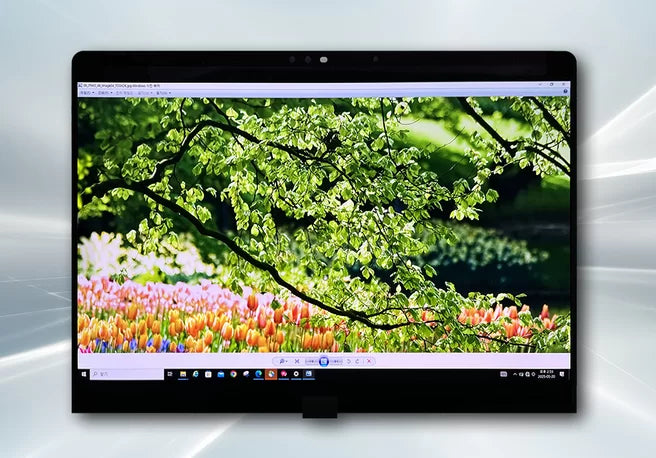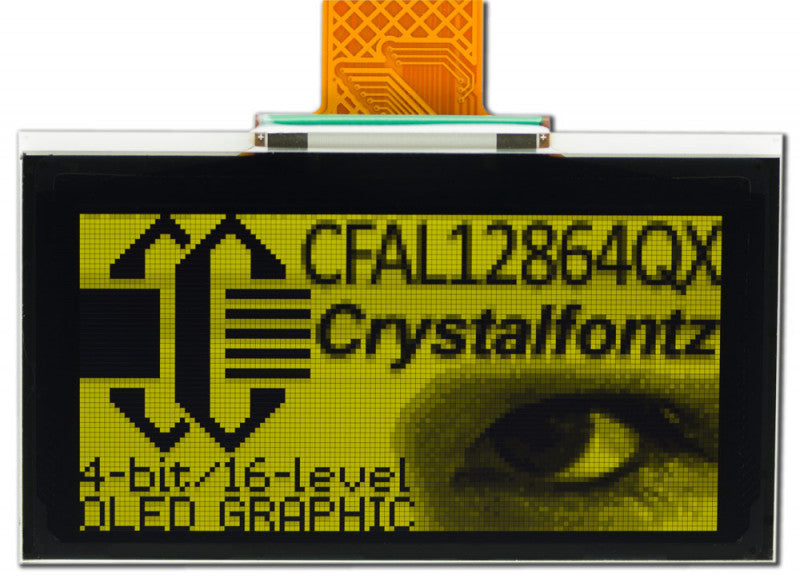PMOLED and AMOLED are OLED display variants differing in driving technology: PMOLED uses a passive matrix, offering low cost but limited to small applications like wearables with refresh rates around 60Hz, while AMOLED's active matrix enables high efficiency and contrast ratios exceeding 100,000:1.
How They Work Differently
For example, a 1.3-inch PMOLED common in fitness trackers uses ~30 rows and 30 columns of electrodes, forcing it to refresh the entire display line by line, which caps its effective refresh rate at ~60Hz and makes large screens impractical—most PMOLEDs max out at 2 inches diagonally due to increasing power loss from overlapping drive signals.
This eliminates the need for line-by-line scanning: a 6.7-inch AMOLED phone screen can update specific pixels independently, slashing response times to <1ms compared to PMOLED’s ~10ms lag. The TFT layer also enables finer control—AMOLEDs achieve >1,000,000:1 static contrast ratios because individual pixels can fully power down, whereas PMOLEDs dim by reducing current across entire rows, limiting contrast to ~1,000:1.
Key mechanical differences include:
-
river circuit complexity: PMOLEDs use external ICs for row/column timing; AMOLEDs integrate TFTs directly onto the glass substrate.
-
ower scaling: PMOLED efficiency drops sharply with size—at 1 inch, it uses ~5mW/cm², but jumps to ~50mW/cm² at 2 inches. AMOLED power stays steady at ~8–12mW/cm² across 1–7-inch sizes.
-
ifespan impact: PMOLED’s constant row activation stresses organic layers, reducing lifespan to ~20,000 hours at full brightness. AMOLED’s pixel-level control extends this to ~50,000 hours under similar conditions.
|
Feature |
PMOLED |
AMOLED |
|---|---|---|
|
Pixel Control |
Row/column electrode scanning |
Dedicated TFT per pixel |
|
Max Practical Size |
2 inches |
7+ inches (e.g., foldables) |
|
Refresh Rate |
~60Hz |
<1ms (effectively unlimited for displays) |
|
Contrast Ratio |
~1,000:1 |
>1,000,000:1 |
|
Power Efficiency (1–2”) |
Drops from 5mW/cm² to 50mW/cm² |
Steady 8–12mW/cm² |
|
Typical Lifespan |
~20,000 hours |
~50,000 hours |
These differences explain why PMOLED dominates cheap wearables—its simple structure cuts costs to ~3 per panel, contrast, and responsiveness justify its ~15 panel cost.
Where You Find Them
PMOLED fits into tiny, budget-friendly gear—60% of digital fitness trackers and basic smartwatches use: 90% of premium smartphones (think iPhones or Samsung Galaxies) and 75% of foldables rely on it, plus many TVs and mid-range wearables.
You’ll spot PMOLED first in entry-level fitness trackers—brands like Fitbit’s Inspire 3 or Garmin’s Vivosmart 5 use it for their 1.1–1.3-inch screens because it’s dirt-cheap (3 per panel) and simple enough for showing steps, heart rate, and battery life. PMOLED’s ~60Hz refresh rate handles static numbers just fine, and its low power draw (~5mW/cm² at 1 inch) keeps batteries lasting 5–7 days.
Next, calculators and electronic shelf labels (ESLs)—Casio’s classic CA-53W calculator still rocks a 0.8-inch PMOLED, and supermarkets love PMOLED ESLs: they sip power so slowly (<1mW/cm²) that price tags stay updated for 5+ years without battery changes. Even medical gear like glucose meters picks PMOLED, and its low cost keeps meters under $20 for users. But PMOLED hits a wall at size: try to make a 3-inch screen, and power use skyrockets to ~50mW/cm², making it hot, inefficient, and useless for anything beyond tiny gadgets.
Premium smartphones are its cash cow—70% of all AMOLED panels ship to phones like the iPhone 15 Pro or Samsung Galaxy S24 Ultra. These screens use AMOLED’s per-pixel control for >1,000,000:1 static contrast, so blacks look actually black(not gray like LCDs), and peak brightness hits 1750 nits. Foldable phones like the Samsung Galaxy Z Fold 5 depend on AMOLED entirely: its flexible TFT substrate bends up to 200,000 times without breaking.
AMOLED also owns large TVs—LG’s C3 OLED TV crams AMOLED into 83-inch panels with perfect blacks and infinite contrast, while a PMOLED TV is literally impossible (max size 2 inches). Even mid-range wearables now upgrade to AMOLED: Apple Watch Ultra ditched PMOLED in 2022, paying ~$12 per panel to get better color accuracy and <1ms response time. PMOLED’s ~10ms lag would make scrolling feel choppy.
Market numbers prove this split: Omdia reports 1.2 billion PMOLED panels shipped in 2023, almost all for small screens. AMOLED? 5.8 billion panels, with phones taking 70% and foldables growing at 35% year-over-year. Car displays are next—analysts say AMOLED will be in 25% of new cars by 2027, thanks to its brightness (up to 2000 nits for HUDs) and flexibility (for curved dashes).

Comparing Image Quality
AMOLED hits >1,000,000:1 static contrast (true blacks from per-pixel shutdown) vs PMOLED’s ~1,000:1 (rows dim together, graying blacks), <1ms response time (zero blur) crushes PMOLED’s ~10ms (faint trails), and covers 95% sRGB/85% DCI-P3 color gamut vs PMOLED’s 70% sRGB.
Try scrolling a news app on an iPhone 15 Pro (AMOLED) vs a Garmin Vivosmart 5 (PMOLED): the latter leaves faint trails behind moving headlines. DisplayMate tests confirm top AMOLEDs have Delta E <2 (near-perfect color), while PMOLEDs hover at 3–5.
Viewing angles add another layer: AMOLED keeps colors consistent at 178 degrees. PMOLED maxes out at 120 degrees.
Brightness matters too: AMOLED peaks at 1750 nits (sunlight-readable on phones or car HUDs), while PMOLED tops at 500 nits, and PMOLED’s glow fades to a dim blur. Longevity hits image quality too: AMOLED’s pixel-level control slows color decay—after 5,000 hours, it stays within 5% of original color. PMOLED’s row-scanning wears out blues fastest—after 3,000 hours (a year of daily use), your Fitbit screen looks yellowish—10% color shift, per DisplayMate. That’s why foldables like the Galaxy Z Fold 5 stick with AMOLED: its color stays vivid after 200,000 bends.
Market stats back this: Omdia found 92% of AMOLED phone users rate color/contrast “excellent,” vs just 65% of PMOLED wearable users.
Power and Lifespan Factors
PMOLED sucks more power as it gets bigger—1.3-inch fitness trackers burn ~5mW/cm², but crank that to 2 inches and it jumps to ~50mW/cm²—while AMOLED keeps power flat at ~8–12mW/cm² no matter the size. Lifespan splits too: PMOLED’s row-scanning fries organic layers, dying to ~20,000 hours at full brightness, while AMOLED’s pixel-level control stretches that to ~50,000 hours.
That’s why a tiny 0.8-inch calculator PMOLED sips <1mW/cm² (lasts years on a button cell), but a 2-inch PMOLED smartwatch? It’ll drain your battery in 3 days flat if you leave the screen on, which uses ~10mW/cm² to keep its 1.92-inch screen alive for 36 hours of heavy use. That’s why foldables like the Samsung Galaxy Z Fold 5 (with a 7.6-inch AMOLED) can handle 12 hours of video playback without overheating: no row-scanning chaos, just targeted power.
PMOLED’s constant row activation wears out the blue organic layer fastest (blues degrade quicker than red/green), so after 3,000 hours (about a year of daily use), your Fitbit Inspire 3’s screen starts looking yellowish—10% color shift measured by DisplayMate. AMOLED avoids this: since each pixel is independent, there’s no “scanning” stress—after 5,000 hours, an LG C3 OLED TV’s color stays within 5% of original, so blacks still look black, not faded gray.
Omdia found 78% of PMOLED wearable users complain about screen dimming after 2 years, versus just 32% of AMOLED phone users. Medical glucose meters stick with PMOLED not for lifespan, but because they only update once every few minutes—low usage means the ~20,000-hour rating is plenty. AMOLED’s efficiency and longevity win: a Samsung Galaxy S24 Ultra’s AMOLED will still look crisp at 50,000 hours—that’s 13 years of 10 hours a day use.
Making the Right Choice
Choosing between PMOLED and AMOLED comes down to three non-negotiables: PMOLED dominates tiny, budget gear (<2 inches, 3 per panel)—80% of fitness trackers like Fitbit Inspire 3 use it—while AMOLED rules bigger, premium screens (15 per panel) where contrast or speed matters—90% of premium phones (iPhone 15 Pro, Samsung S24 Ultra) and 75% of foldables rely on it.
Size is your first hard limit—PMOLED’s passive matrix design physically caps at 2 inches diagonally. Push beyond that, and power use explodes from 5mW/cm² at 1 inch to 50mW/cm² at 2 inches—why electronic shelf labels (ESLs) or Casio’s 0.8-inch calculator stick with it: they don’t need flashy visuals, just small, cheap screens that sip power. AMOLED? Its active matrix with TFTs bends 200,000 times without damage (perfect for Galaxy Z Fold 5’s 7.6-inch foldable) and scales to 83-inch TVs (LG C3 OLED) without losing quality. If you’re building something larger than 2 inches.
Cost is next—PMOLED’s simplicity saves cash: 3 per panel vs AMOLED’s 15. Fitbit keeps its Inspire 3 under , which most budget buyers skip. But AMOLED’s premium pays off for flagships: Apple Watch Ultra charges $799 extra for its AMOLED screen, and users justify it for better color accuracy (Delta E <2 vs PMOLED’s 3–5) and faster response (<1ms vs 10ms) when tracking outdoor runs.
AMOLED’s >1,000,000:1 static contrast (pixels fully turn off) beats PMOLED’s ~1,000:1 (rows dim together). AMOLED’s <1ms response eliminates blur—swipe TikTok on an iPhone 15 Pro (AMOLED) vs a Garmin Vivosmart 5 (PMOLED). For low-power, long-life gear like glucose meters, PMOLED’s ~5mW/cm² draw works—after 20,000 hours (a year of daily use), it’s still readable. But for daily drivers? AMOLED’s ~50,000-hour lifespan means it won’t fade—Tesla’s Model 3 center screen stays crisp for 10 years; a PMOLED would be blurry by year 5.
Omdia’s 2023 data backs this: 1.2 billion PMOLED panels shipped. 5.8 billion panels, with 70% going to phones. 92% of AMOLED phone users call image quality “excellent”; just 65% of PMOLED wearable users do.
Read more

PMOLED, short for Passive Matrix OLED, is a display tech using simple row-column electrode grids to light pixels sequentially, perfect for small screens like smartwatch faces; two standard polymer ...

This IPS Display Guide covers types (standard, Nano IPS), pros like 178-degree viewing angles and ΔE<2 color accuracy, and use cases: favored by designers for precise hues, photographers for tru...



Leave a comment
This site is protected by hCaptcha and the hCaptcha Privacy Policy and Terms of Service apply.